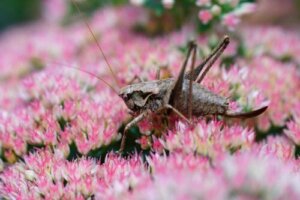How to Safely Eliminate Crickets or Grasshoppers from Your Garden

Summer wouldn’t be summer without the chirping of crickets at dusk. Whether we like it or not, that peculiar sound takes us back to warm evenings in the garden or on the terrace. But these animals are also harmful to plants, so it’s important to know how to eliminate crickets or grasshoppers from your garden.
Although these insects from the Orthoptera family do not transmit diseases and are harmless to people, their presence is unwanted among our plants, which they can eat. So, what can you do about it? Let’s take a look.
Crickets or grasshoppers?
Crickets and grasshoppers are very similar to each other, and it’s common to confuse them. Both crickets and grasshoppers have antennae that are longer than their bodies.
However, crickets have a sturdier body and are brown or black in color, while grasshoppers are gray, green, or brown. Both have nocturnal habits and feed on the leaves of plants.
The former are rather terrestrial and the latter like the foliage of trees. They measure between 2 and 5 centimeters long, although there are larger and smaller ones.
They have the ability to devour leaves, vegetables, flowers, and fruits at an unimaginable speed. In general, they lay their eggs in neglected areas of the garden and when they hatch, they migrate to the richest areas of the park.
In some Eastern cultures, these insects are a symbol of good luck and fortune. This is why you may have heard it said that a cricket in the house brings luck or money and shouldn’t be taken out. However, it may become impossible to rest with its sounds in the background. Anyway, in many countries, crickets and grasshoppers are real pests.
They prefer to live in the garden and not inside the home. However, when the external conditions aren’t right, they often seek refuge in homes. They could be very harmful, as they can damage clothes, carpets, armchairs, and cushions.

We think you may also enjoy reading this article: Avoid These 7 Gardening Mistakes and Make Your Plants Bloom in Spring
How to eliminate crickets or grasshoppers from your garden
The first sign that you have crickets living in your garden is chewed leaves on your plants. This means that these insects are in the prime of their cycle and are feeding on your vegetables.
The key is to use safe and natural methods to get rid of crickets in the garden. Although there are insecticides that can put an end to their presence, let’s start with practices that are harmless to our health.
Crickets lay their eggs (between 150 and 400) when summer is coming to an end, hatch at the end of spring, and are ready to devour any plant that crosses their path. On the other hand, remember that they have nocturnal habits, but they prefer well-lit places. That is, you could change the white or cold lights in the garden for yellow or warm ones and direct them to where there are no plants.
Tips to get rid of crickets or grasshoppers in your garden
Here are some of our tips to keep crickets and grasshoppers away from your plants and your home:
- Sprinkle garlic pieces around potted plants and other areas of the garden. This particular scent is a natural repellent against this type of insect. You can also prepare a garlic infusion using one clove per liter of water. Then, spray the plants with this liquid.
- Paprika: Here, you’re also going to prepare an infusion and we are going to use one of these peppers per liter of water. After boiling everything, spray this preparation on the plants.
- Neem oil: This is a natural insecticide that doesn’t harm the environment and will help you to eradicate aphids and spider mites, as well.
- Short grass and clean yard: Try to keep the grass of your lawn short and the garden free of weeds, since it’s in the most neglected area of the yard where they lay their eggs.
- Diatomaceous earth: This is a harmless product for human health, but it’s deadly for some insects. This is because when they come into contact with this dust, they dehydrate and end up dying.
- Nitrogen-fixing plants: Some legumes accumulate nitrogen in their roots and discourage crickets from eating them. The same happens with potatoes, garlic, and coriander.
- Entry holes: Try to seal all the holes through which crickets can enter your house.
- Natural predators: Pets such as dogs and cats will follow their natural instinct and hunt crickets and grasshoppers. Another interesting idea is to build a bird feeder and bath, because birds also feed on these insects.

Like this article? You may also like to read: Learn 5 Benefits of Gardening for Your Mental and Emotional Health
Eliminating crickets or grasshoppers from your garden is possible
So far, we’ve emphasized the choice of natural and harmless methods to get rid of these animals that inhabit your outdoor spaces. However, if you notice that the situation is out of control, you should consult a plant nursery or pesticide store for a special product to suit your needs.
Always follow the manufacturer’s instructions, since these mixtures have chemical components. Misused pesticides can represent a big health hazard.
All cited sources were thoroughly reviewed by our team to ensure their quality, reliability, currency, and validity. The bibliography of this article was considered reliable and of academic or scientific accuracy.
- Ramírez Suárez, T. F., & Ramírez Calderón, I. P. (2018). Obtención y propuesta de producción por lotes de un repelente natural a base de aceite de neem.
- Guerra-Maldonado, G. (2021). El aceite de Neem (Azadirachta indica A. Juss) una alternativa a los insecticidas químicos. Hombre, Ciencia y Tecnología, 25(1), 122-129.
- Baglione, L. (2011). Usos de la tierra diatomea. Revista Tecnicaña, 27, 31-32.
- Bolívar, I. (1878). Sinópsis de los Ortópteros de España y Portugal. T. Fortanet.
- Bedoya, T. C. Biología de Animales.
- Romero, M. J. M. (2008). Vida bajo tierra. Mundo subterráneo: Revista de espeleología, (1), 7-9.
This text is provided for informational purposes only and does not replace consultation with a professional. If in doubt, consult your specialist.








